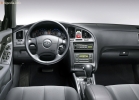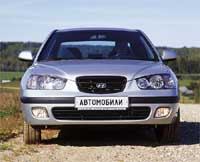Hyundai Elantra 4 doors 2000 - 2003 sedan
Please love
Advantages are not limited to low priceThe goods are face
 Hyunde Elantra (aka Lantra, aka Avanta) has been produced since 1990. The first generation of cars turned out to be a long -liver - facelifting had to wait until 1999, but then the fresh stream scored with a key, and in 2000 the second generation was born, the gamut of the engines expanded.
Hyunde Elantra (aka Lantra, aka Avanta) has been produced since 1990. The first generation of cars turned out to be a long -liver - facelifting had to wait until 1999, but then the fresh stream scored with a key, and in 2000 the second generation was born, the gamut of the engines expanded. The car is equipped with 1.6 gasoline engines; 1.8 and 2.0 l with a capacity of 79, 97 and 104 kW (107, 132 and 141 hp) and a diesel engine with a boost and system of the RALL RALL 2.0 liter, 82.5 kW (112 l.) . True, official dealers deliver to Russia to an Endra only with a 1.6 -liter engine.
The car is offered in five trim levels. The simplest - with a five -speed manual gearbox, air conditioning and audio training - will cost $ 13,280. The rest is accepted for an additional fee: climate control, ABS, heating seats and mirrors, full of electric package. Among the options of the radio with six speakers, the salon filter and the air control system, the leather upholstery of the steering wheel and the KP handle, the fog lights. For autolets, of course, they offer an option with an automatic four -speed box. A fully packed car will pull about $ 15,500 in the version with mechanics and $ 16,500 with an automaton. A sophisticated car with a manual box fell into our hands.
WHAT'S INSIDE?
 Having barely opened the driver's door, we mark the first curious detail. The skin finish, in addition to the steering wheel and the handle of the gearbox, is also present on the front door handles. Already when landing, the driver is made to understand: he is happy here. We will use the invitation and close the door behind us.
Having barely opened the driver's door, we mark the first curious detail. The skin finish, in addition to the steering wheel and the handle of the gearbox, is also present on the front door handles. Already when landing, the driver is made to understand: he is happy here. We will use the invitation and close the door behind us. Before moving on the road, it is convenient to get a job at the workplace. This takes some time, first of all, because the driver's seat has five adjustments and plus another steering wheel. Having adapt to one position of the steering wheel, we feel that the landing is still not perfect. Raise, let the steering wheel and again sit on the seat. X-mm, but it turned out nothing.
Conveniently settled in an armchair, they took up the mirrors. In our configuration, they are regulated by servo. The mirrors themselves are not very large, but with a bulge is slightly larger than usual, which is especially unusual on the left side (we are used to the right - convex and the left is almost flat). In general, the visibility is good, except that the rear dimensions of the car do not feel the way you would like - a consequence of the licnetiness of the back of the car.
In the driver's place, as, however, to the right of it, there is enough space. There are even features that encourage very large people to look at the car. Firstly, the seat completely lowered down leaves an impressive distance to the ceiling.
 A specially trained mannequin did not even have a scale - I had to substitute a ruler. They measured 111 cm from the pillow (under load). Secondly, in Elantra with mechanics, the gear lever is a little further pushed to the right than usual, and this is an additional space for the right leg of a solid person.
A specially trained mannequin did not even have a scale - I had to substitute a ruler. They measured 111 cm from the pillow (under load). Secondly, in Elantra with mechanics, the gear lever is a little further pushed to the right than usual, and this is an additional space for the right leg of a solid person. By tradition, a few words about the rear seats. For passengers who are here, not only the traditional ashtray is provided: there are also cup holders, and a falling armrest with a small box inside.
How is it going?
We agree that the good riding of the car is the harmony of traction, controllability, cinematics of the suspension, the rigidity of the body and other things, other things. But let us formally divide the one and indivisible into three components: what is associated with the steering control, with the suspension and with the dynamic capabilities of the car.
It is easy to guess that the 1.6 liter engine, sharpened for modern environmental norms, is unlikely to amaze the driver with his capabilities: from the standpoint of dynamics, he allows him to go either well or normally. The Elantra engine in this sense is somewhere in the middle. You can’t say that there are no lower classes, but at the same time you will not emphasize that they are. It seems to be picked up after 2500-3000 rpm, but not the most expressive. Character? Let's call him moderately naporous.
 Suspension. Perhaps in this car it can be called typically Korean, but well -brought. Maybe there is no honed controllability at high speeds, but there is no folly - a frequent companion of Asian comfort. Moderate passages of the suspension, the average for modern cars, stiffness and very specific shock absorbers. They are not Soviet - with thumping in fossa, but impressiveness on the waves, and not German, well working at high speeds and comfortable only on a good road. Hyunde copes well with medium -sized pits and quite confidently keeps the road at moderate speeds. With slow driving along the big bumps, sidelines shake more strongly than in Moskvich or Samara, but weaker than in classmates from Audi or Volkswagen. On a large (for 120 km/h) speed, on the contrary, an Elantra is not a dangerous competitor for the Germans - she will be able to claim leadership in a couple with our ten.
Suspension. Perhaps in this car it can be called typically Korean, but well -brought. Maybe there is no honed controllability at high speeds, but there is no folly - a frequent companion of Asian comfort. Moderate passages of the suspension, the average for modern cars, stiffness and very specific shock absorbers. They are not Soviet - with thumping in fossa, but impressiveness on the waves, and not German, well working at high speeds and comfortable only on a good road. Hyunde copes well with medium -sized pits and quite confidently keeps the road at moderate speeds. With slow driving along the big bumps, sidelines shake more strongly than in Moskvich or Samara, but weaker than in classmates from Audi or Volkswagen. On a large (for 120 km/h) speed, on the contrary, an Elantra is not a dangerous competitor for the Germans - she will be able to claim leadership in a couple with our ten. We got to the steering. Here we will be concise: such a steering wheel would not hurt our cars. A little more than three revolutions from the stop to the stop - quite sensitive, but, moreover, absolutely not nervous. Allows you to quickly go around the pit, but does not strain on the suburban highway. Of course, this is not the limit of perfection: let's say, the accuracy of the perception of the driver’s teams by modern standards will be appreciated only at four.
On the sidelines
 Among those who often drive everything that have wheels, a stable performance has developed in relation to Korean cars. Unconditional advantages always include a low price. To the disadvantages - the lack of an interesting nature, a very calm (often with small flaws) controllability and the ability to always complain about something in the interior or ergonomics. But one cannot but notice that these cars from generation to generation are changing, and for the better. And Elantra is a convincing example. In its interior, the features of not modern Korean, but simply a modern car are drawn. The steering wheel, suspension and, in general, handling do not cause complaints. We have to talk more and more about the features and less about the disadvantages. Interesting character? Probably, he will appear. And when this happens, a little more will have to be squeezed out both the grandmother's faces and our manufacturers of wheeled equipment. I wonder if they are ready for this?
Among those who often drive everything that have wheels, a stable performance has developed in relation to Korean cars. Unconditional advantages always include a low price. To the disadvantages - the lack of an interesting nature, a very calm (often with small flaws) controllability and the ability to always complain about something in the interior or ergonomics. But one cannot but notice that these cars from generation to generation are changing, and for the better. And Elantra is a convincing example. In its interior, the features of not modern Korean, but simply a modern car are drawn. The steering wheel, suspension and, in general, handling do not cause complaints. We have to talk more and more about the features and less about the disadvantages. Interesting character? Probably, he will appear. And when this happens, a little more will have to be squeezed out both the grandmother's faces and our manufacturers of wheeled equipment. I wonder if they are ready for this? 1. For the driver - five seats adjustments.
2. For passengers - cup holders and a glove compartment.
3. All electric drives together.
4. The glass has become familiar among small -class machines.
5. The trunk corresponds to expectations.
6. The engine is only one - 1.6 liters.
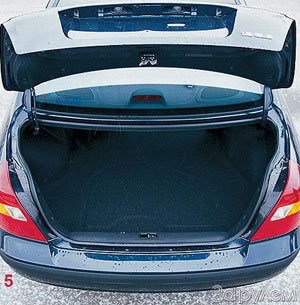 Hyunde Elantra, 1.6 liters, 16 classes, 79 kW
Hyunde Elantra, 1.6 liters, 16 classes, 79 kW Length x width x height, mm 4495x1720x1420
Maximum speed, km/h 182
Acceleration 0-100 km/h, from 11.0
Fuel consumption 9.4/6.2/7.4
(city/highway/medium), l
Prices for spare parts and then, US dollars
Then 15,000 km 280
Then 30,000 km 330
Then 45,000 km 300
Front brake pads 50
Rear brake pads 45
Timing belt+videos+work 57+45+175
Front bumper 160
Bamper rear 170
Hood 200
Front door 255
The rear door is 240
Front wing 90
Windshot Origin./Neorigin. 270/220
Block Fara 170
Rear lamp 85
The cost of a norm-hour of work 55
Warranty: for a car - 3 years or 100 thousand km; on the power unit - 5 years or 120 thousand km.


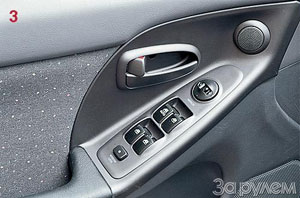

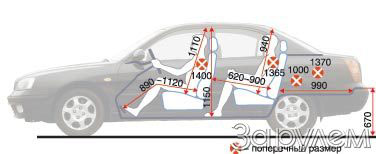
Text / Alexander Budkin
Photo / Alexander Batyr
A source: The magazine "Driving"
Hyundai Elantra 4 doors 2000 - 2003 Video
Hyundai Elantra 4 doors 2000 - 2003 test drives
Hyundai Elantra 4 doors 2000 - 2003
Krassh Test: Detailed Information20%
Driver and passengers
16%
Pedestrians




